 Nuclear-Powered Guided Missile Cruisers: USS California, USS South Carolina (CGN-36, 37) 1970-1999.
Nuclear-Powered Guided Missile Cruisers: USS California, USS South Carolina (CGN-36, 37) 1970-1999.US Cold War Cruisers:
Worcester | Des Moines | Juneau | Boston | Galveston | Providence | Albany class | Long Beach | Leahy | Belknap | Bainbridge | Truxtun | California | Virginia | Ticonderoga | Strike Cruiser (CSGN)The California class was were two nuclear-powered guided-missile cruisers operational from 1974 and 1998, and designed as such rather than simply stretched Leahy/Belknaps fitted with reactors. They reprsented the synthesis of experience gained since the Long Beach, yet still lacked helicopter hangars. They were larger than the previous USS Bainbridge and Truxtun and were meant to possess high endurance to stay deployed with USN Carrier Battle Groups, against conventionally powered escort’s continuously turnover. These Newport News ships were still relatively costly to operate and saw less action than their forebears due to the end of the cold war. Now a bit forgotten, “Golden Grizzly” and “the Mighty Socar” were mostly present during the Middle East crisis, and culminating with Operation Desert Storm. They earned their share of decorations, 6 Meritorious Unit Commendations, 7 Battle Efficiency “E”, 3 Expeditionary Medals for California alone. #coldwar #guidedmissilecruise #USN #usnavy usscalifornia
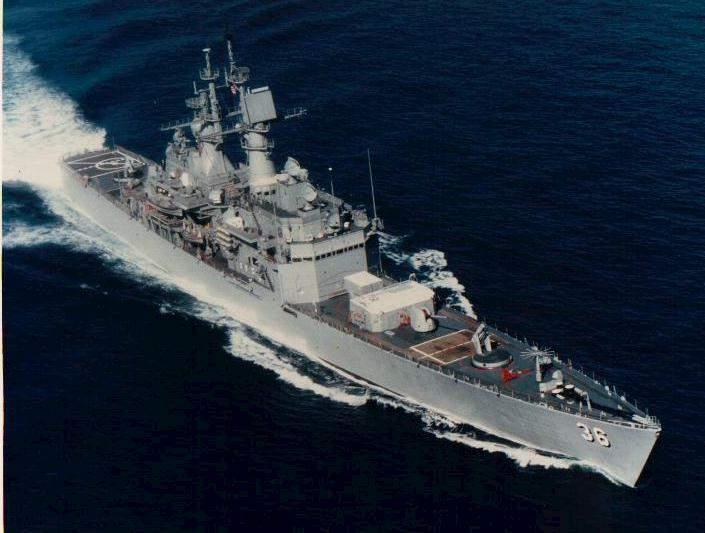
These two ships were nuclear versions of the abortive conventionallypowered FY66 guided missile destroyer, built under the FY67 and FY68 programme, the first long lead time items having been bought under the FY66 programme. A third ship, partially funded in FY68, was built instead of a new design. Their construction was quite expensive, and by the late 1960s Secretary of Defense McNamara was unwilling to release funds for them; they were built as a result of Congressional pressure.
The design originally called for a pair of heavyweight Mk 42 5in/54 guns and two torpedo tubes for Mk 48 torpedoes, in the transom; the tubes were discarded and lightweight Mk 45 guns substituted. The missile battery was controlled by the new digital Tartar-D (SPG-51D) fire control system, and, compared to the Bainbridge and Truxtun, they had 1mproved D2G reactors with about three times the core lifetime. A helicopter landing area was provided aft, but they had no hangar, as they were designed during the gap between DASH and LAMPS. The Californias have been described as the first US nuclear surface ships intended for series production. They were redesignated ‘cruisers’ (CGN) in 1975.
Kevlar armour was added over vitals. NIU: added during FY89 and FY90, SPS-49 replacing the earlier SPS-40 radar.
ASROC was removed in 1993, Both were retained (to decommission 1998—99) because they have been refuelled 1992-93.
Development
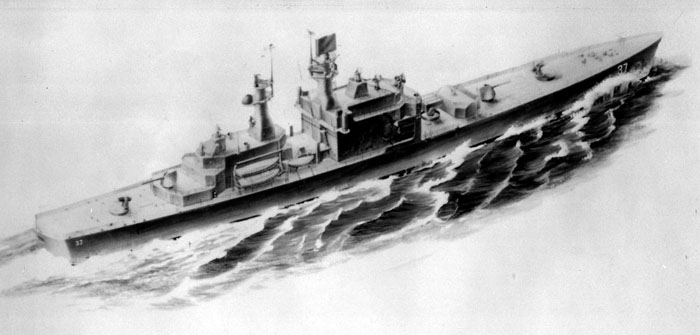
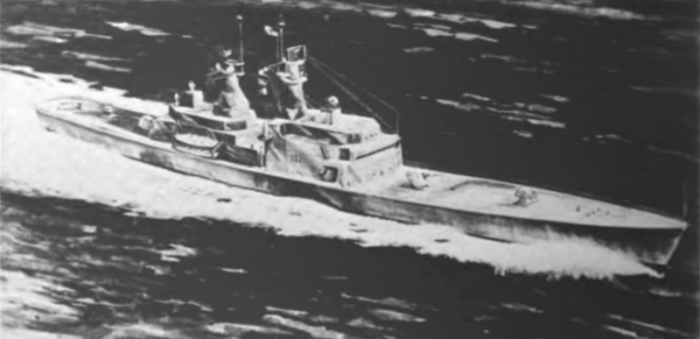
Artists view of the class as presented in 1967 documentation.
These two cruisers became essentially as nuclear versions of the abortive FY66 guided missile destroyer, planned under FY67 and FY68 programmes. Delays caused this as they were initially planned under the FY66 programme. A third ship was partially funded in FY68, but a new design was chosen instead. Construction for the new Frigates was quite expensive, and by 1968, Secretary of Defense McNamara retained funding and only ceded to Congressional pressure.
The Directive 252 of 18.5.65 planned for the FY66 ships (Pr. 200.66) as a continuation of SCB 199C. The frigates were essentially a development of the Leahy-Belknaps with nuclear power, but they were inded as longer “double ender” vessels to replace the 1950s converted guided missile cruisers such as the Boston, Galveston and Providence classes on the long run.
The design originally called for two Mk 42 127mm/54 guns, two Mk 48 torpedo tubes in the transom stern, but this solution, orived unsatisfactiry and they were discarded later in the design process, whereas the lightweight Mk 45 guns were substituted for stability concerns.
The missile battery was initially two include two two-armed Tartar launchers, one each fore and aft, both controlled by the new digital Tartar-D (SPG-51D) fire control system. Compared to the Bainbridge and Truxtun, they had improved D2G reactors with a much imprpved (thrice) core lifetime. They also received a helicopter landing area aft, but still lacked hangar. They arrived at the time DASH was considered unreliable and and LAMPS was not yet ready, in early R&D. The nuclear-powered Frigates (at the time of theior design) were described as the first series production nuclear-powered vessels, and before even they were redesignated ‘cruisers’ or CGN in 1975, they were the first US surface ships to sign the return of state names, like the battleships of old.
Thus USS California commemorated the previous USS California BB-44 of the Tennessee class, veteran of two world wars and her sister USS North Carolina, first fast battleship in US History.
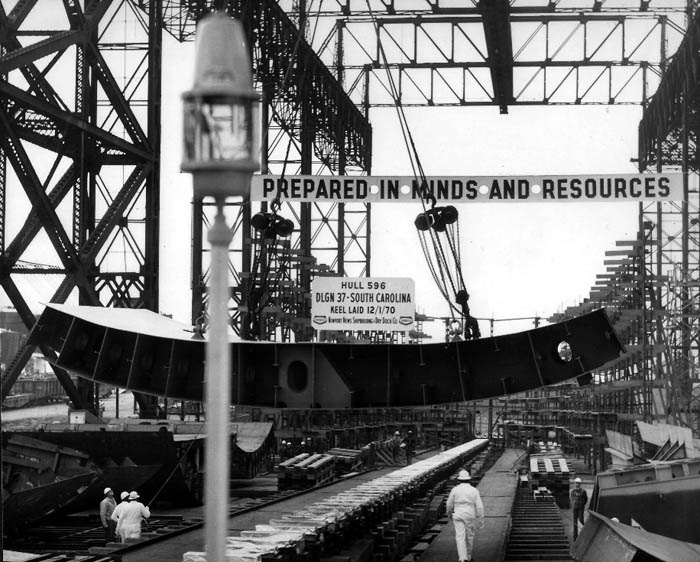
Keel Laying of USS South Carolina, src navsrc.org
They were tailored to deal with air, surface, and subsurface threats with high-speed aircraft carrier task forces or amphibious task forces over extended periods anywhere in the world. They come in adition of a quite complete armament, with a fully integrated combat system with computers for high-speed data processing. They were also as said, the first intended for series production, albeit later deemed too costly still, limiting the clas to just two ships. The copy was reviewed later, leading to the next Virginia class missiles cruisers, more automated and a bit less costly, but still themselves were axed when derivatives of the new Spruance class FFs was looked upon unstead, to carry the AEGIS system (Ticonderoga class).
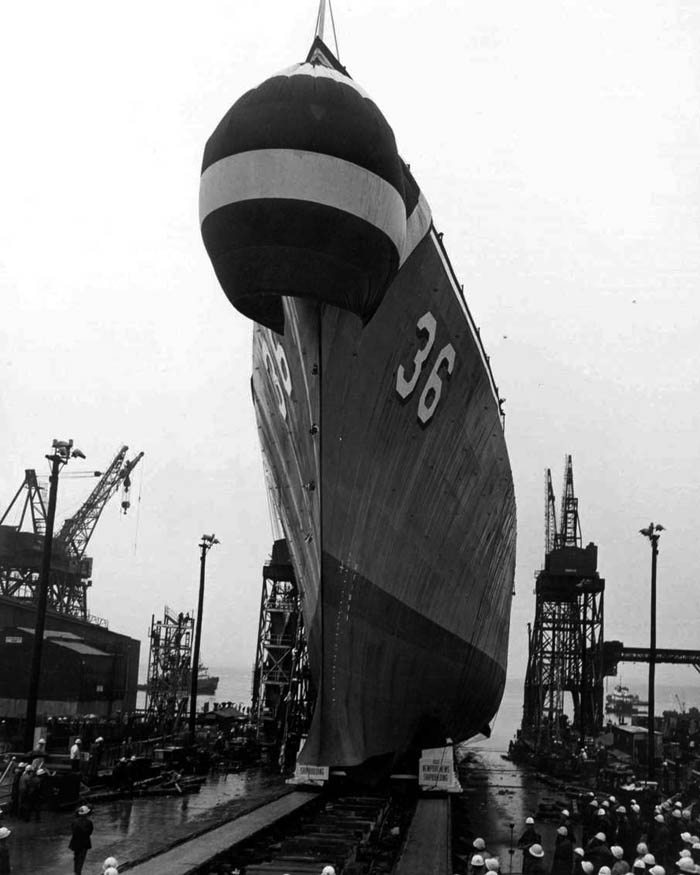
USS California launch – src navsrc.org
Unfortunately not much plans or details had been made open source yet on the California class, despite the 55 years had passed since the plans were approved back in 1969.
USS California (CGN 36) was laid down at Newport News Shipbuilding and Dry Dock Company in 23 January 1970 and her sister North Carolina (CGN 37) at the same, but on 1 December 1970, nearly a year later. This new tradition was repeated on the next Virginia class, then abandoned as the Ticonderoga were named after battles.
Design of the class
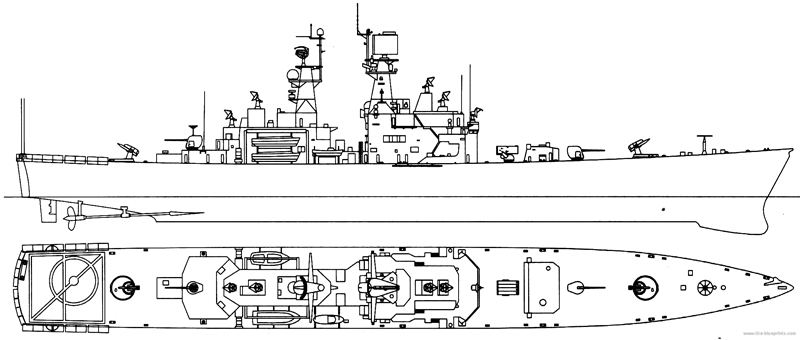
Hull and general design
The California class shared the same continuous hull with the Bainbridge/Truxtun, with a long rectangular section, large transom stern, fine entries with a sharp bow, and the armament taking most of the useful deck space, leaving two island supersructures amidship, the bridge block and stern block, swith steps, articulated around their macks (mast+stacks) caryying their main aerials. The two forward and two aft FC radars were installed in superfiring positions. The blocky bridge went all the way from beam to beam, and integrated deck access doors bulwarks and wings above. The was an open deck above the three-faceted bridge deck, offering some panoramic vision. The class was rated for 10,600 long tons (10,800 t) fully loaded, xxx standard, for an overall lenght of 587 ft (179 m), a beam width of 61 ft (19 m) and a 31 ft 6 in (9.60 m) draft.
The macks had round section but squared bases, supported the main aerials while having top exhausts below the platforms. They were quite close together amidships, of different height between for foremast and aft mast, creating an generally handsome stepping profile. They were much more pleasing to see compared to the Truxtun/Bainbridge and their spread out design and massive lattice masts.
The narrow intermediate space between islands was taken by a platform later use to support the Harpoon canisters, and the four service boats, two fast VIP transports and two cutters were installed under davits along the aft island. Probably the most recoignisable feature was their very long prow, to be able to get a SAM launcher, a main gun, and an ASROC on deck in succession, with ample space between them to avoid interference. The aft deck was much shorter, and space taken by the aft SAM and helideck. The aft 5-in gun was placed on an elevated step of the island.
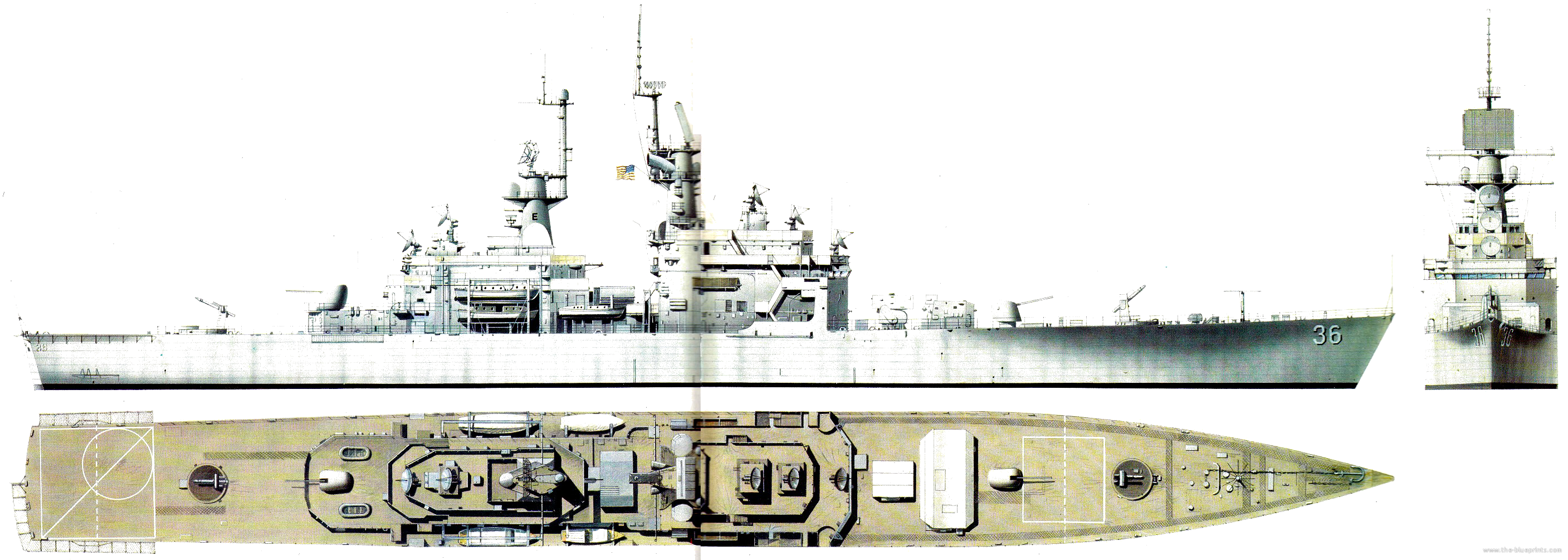
Nice 3 views from Atlas editions, 1985
Powerplant
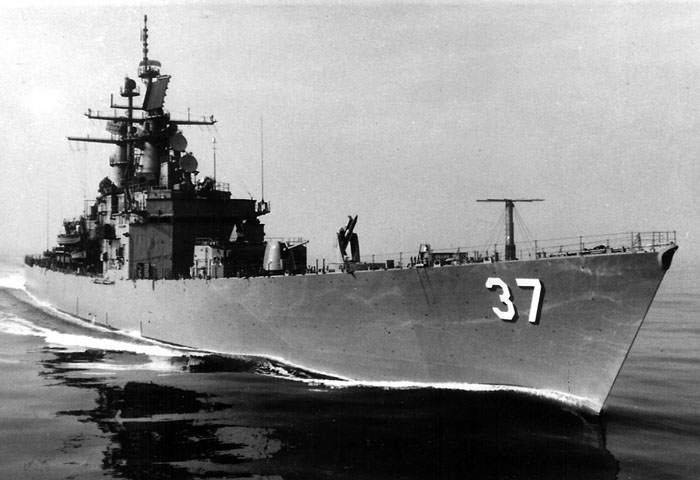
South Carolina in sea trials, src navsrc.org
The California class were given a powerplant comparable to the previous Bainbridge/Truxtun General Electric D2G reactors linked to steam turbines, generating 60,000 shp (45,000 kW), on two shafts connected to five-bladed bronze propellers. There were two tall rudders as well. Speed remains classified to this day, and and is estimated excess of 30 knots (56 km/h). Range of course was unlimited, although the crew had c100 days of food supplies (3 months).
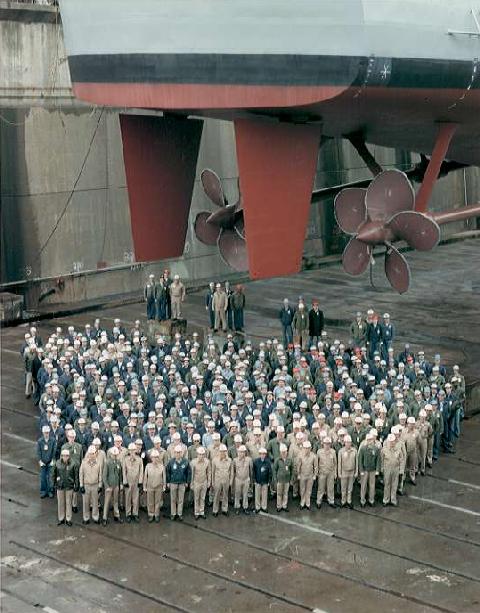
Propellers and rudder
Armament

CGN-36 armament and sensors – src man.fas.org
Main
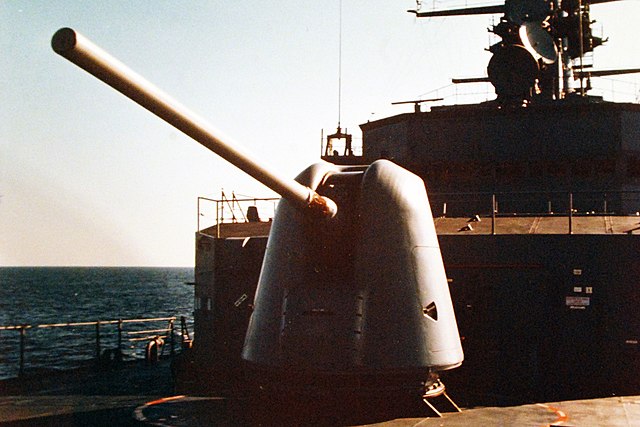
5-in/54 Mk.45
The “universal” 5-Inch/54 Mark 42 gun, 127 mm saw two, for the first time, installed on a nuclear cruiser. It enabled dual purpose fire (air targets past SAM range) or for surface and ground warfare. Fully automatic, dual-purpose, 40 rounds per minute rate of fire and a large array of ammunition, HE, fuse Frag, smoke and exercize round.
⚙ 5-Inch/54 Mark 42 gun |
|
| Turret size | 9.652 m (31 ft 8.0 in) |
| Turret Weight | 60.4 long tons (61.4 t) |
| Barrel | 6.858 m (270.0 in, rifling 5.82 m (229 in) |
| Recoil | 18.75 inches (476.2 mm) |
| Elevation/Traverse | -15°/+85°, rate 25°/sec – 150° from either side centerline, rate 40°/sec |
| Shell | 127 x 835mm .R 31.75 kg (70.0 lb) |
| Muzzle velocity | 2,650 ft/s (807.7 m/s) |
| Rate of fire | 40 rpm automatic original down to 28 rpm 1968 |
| Range (surface) | 25,909 yd (23,691.2 m) at +45° elevation |
| Ceiling (AA) | 51,600 ft (15,727.7 m) at +85° elevation |
| Guidance | Mark 68 gun fire control system with AN/SPG-53 radar |
Standard SM-1MR SAM
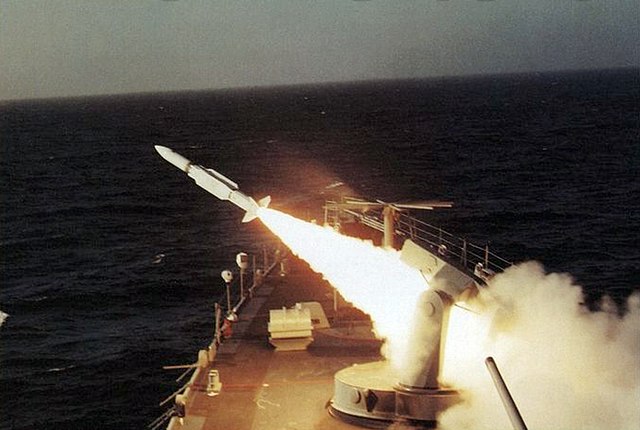
Two single systems, 80 RIM-66 in storage total. The RIM-66 entered service in 1967 so as these cruisers were about to be launched. The RIM-66A is a medium replacement for the Tartar and considered one of the “Standard” missiles derived from the RIM-24C/Mk74 “Tartar” Control System. Same fuselage as the Tartar to be retrofitted on existing launchers and magazines. The RIM-66A/B had redesigned electronics, a more reliable homing system, better fuze. Thus led to the SM-1MR Block I to V making its combat drbut at the very end of the Vietnam War. The latest was the RIM-66E (SM-1MR Block VI), no longer in service.
The first version of 1967 became in production the Block IV (1968) while I-III were prototypes. Block IIIs were also upgraded to Block IV, with better ECCM improvements and still the Tartar Mk 27 rocket motor, and shorter than later versions.
⚙ specifications RIM-66 |
|
| Weight | 562 kg |
| Dimensions | 4.22 x 0.34 x wp 1.07 m |
| Propulsion | Solid propellant, Aerojet MK 27 Mod 4 dual thrust motor |
| Speed | Mach 2 |
| Range | Range 32 km, Altitude 19.8 km |
| Guidance | Semi-active radar homing Seeker, Conical scan passive radar |
| Warhead | MK 51, 62 kg Continuous rod |
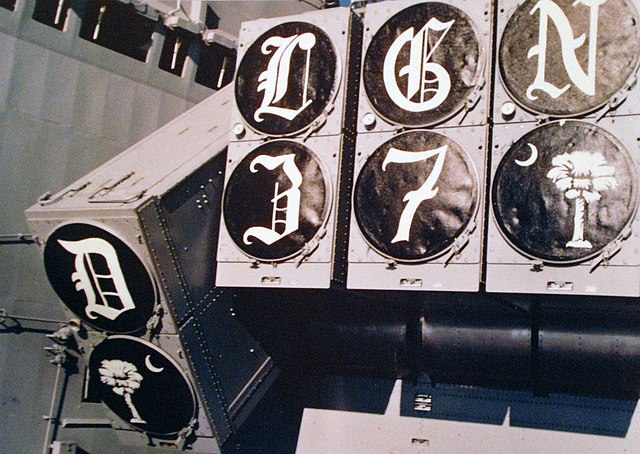
In total 24 RUR-5 were carried in reserve, so just enough for two reloads. The launcher, located immediately forward of the bridge with its reload ramp in front, was the latest type, with separated launcher sections elevating independently.
⚙ RUR-5A Missile |
|
| Container | Full traverse/elevation 8-canister box launcher |
| Weight/size | 1,073 pounds (487 kg), 14.75 ft (4.50 m) x 16.6 inches (420 mm), wspan 26+7⁄8 inches (680 mm) |
| Warhead | Mark 46 Torpedo, HE or 10 kt (42 TJ) W44 nuclear |
| Engine | Solid propellant rocket motor |
| Speed | Subsonic |
| Range | 6 mi (9.7 km) |
| Guidance | Vectoring, beam-riding |
4x 324mm TT
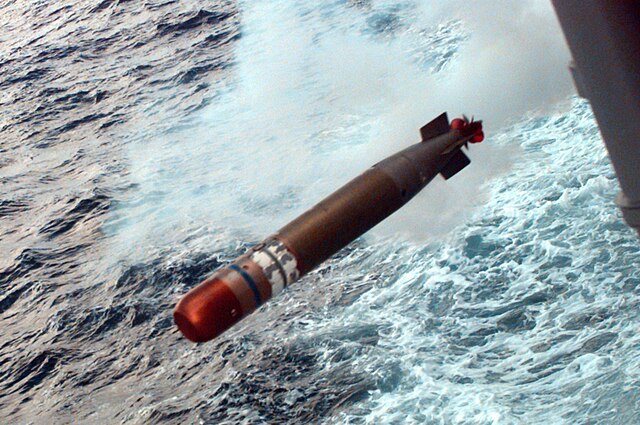
Mark 46 torpedo being launched.
⚙ specifications Mk.46 TORPEDO |
|
| Weight | 259 kg |
| Dimensions | 2.59 meters x 0.324 m |
| Propulsion | Otto Solid fuel turbine motor, twin propeller |
| Range/speed setting | 35 kt at 7.5 km, max depth 350 m |
| Warhead | 45 kg Mk 103 Mod 0 warhead, PBX filling |
| Guidance | Active/passive acoustic seeker 460 m homing range |
Helicopter
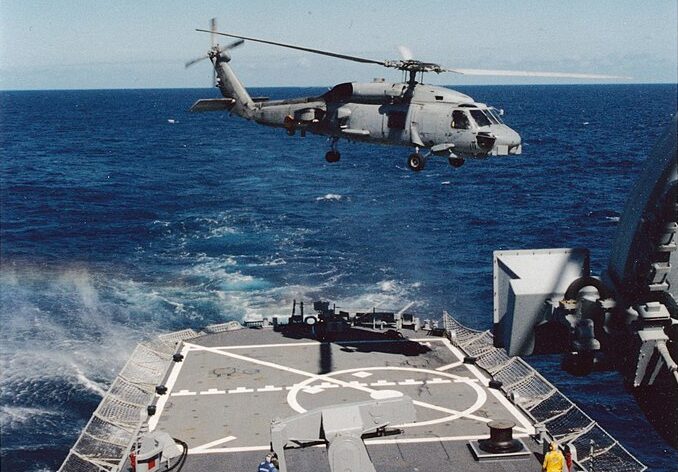
Sikorsky SH-2 Seahawk taking off the aft helideck from USS California.
The two cruisers came with the “capability” to operate a helicopter for short time and given missions, usable for SAR, liaison and ASW patrols if needed, initially the LAMPS III Kaman SH-2 Seasprite, later the SH-60 Seahawk until the end of their career. No hangar means poor serviceability.
Protection
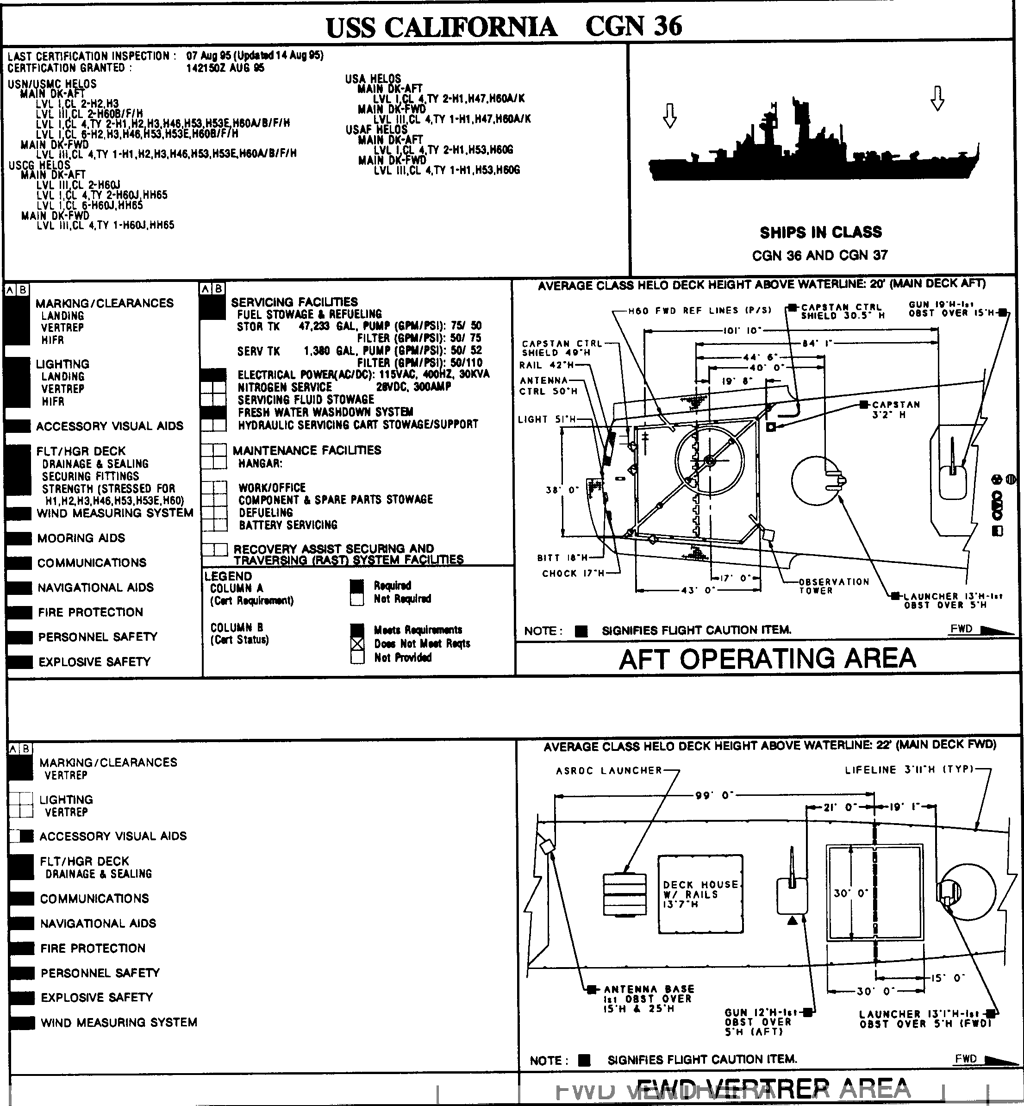
CGN-36 partial plan, src man.fas.org
Kevlar was added later during their career over “vitals” in 1986-87. We can assume the CO (Central Operations), and ammunition storage for the 5-in guns as well as the missile stores. Aluminium used for the superstructure despite the risk of fire hazards. This was learned the hard way on the Spruance class.
As for active protection, they came with the following systems:
AN/SLQ-32
The AN/SLQ-32(V)1 was a simple threat warning receiver for low frequency, high-band radar signals used on SSM terminal guidance radars long-range surveillance radars. It was upgraded during the cruiser’s life to the SLQ-32(v)3 ECM suite in 1982-84.
Mark 28/36 SRBOC
The ships came out with two Mk 28 decoy rocket launchers as completed. In the early 1980s it was replaced by the Mark 36, first of such system installed, interfaced with the AN/SLQ-32 electronic warfare suite. The SLQ-32 can automatically fire decoys from the Mark 36 SRBOCs when detecting an anti-ship missile attack, reducing the reaction time at the minimum. The Mark 36 SRBOC recalled the British Sea Gnat decoy system in concept. The California class carried four Mk 36 SRBOC decoy Rocket Launchers, kept until their decommission.
T-Mk 6 Fanfare torpedo decoy
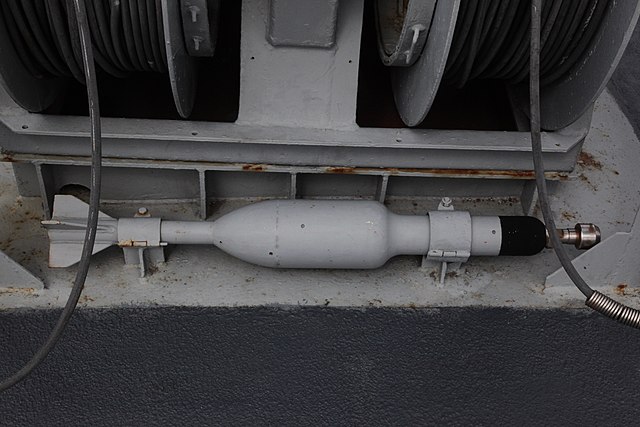
Early towed sonar decoy developed in the 1960s to replace the Foxer noisemaker, way more effective at it replocated propeller souns, and not a wideband noise. Not present at the start, these systems were installed in the early 1980s on the Californias. They were retired and replaced by the Nixie in 1993-94.
AN/SLQ-25 Nixie torpedo decoy

The AN/SLQ-25 Nixie is a towed torpedo decoy comprising the towed decoy device TB-14A and the shipboard signal generator. It is a close defence against incoming wake/acousting homing or wire-guided torpedoes. It emits signals to draw the torpedo away, simulating propeller/engine noise at a specific frequency setup to match the one of the carrier ship. It also aplified and returned the torpedo active sonar own pings. On the California class two Nixie systems were mounted at the stern.
Sensors
AN/SPS-48E 3-D Air search radar
3D air search RADAR first developed in 1966: 17 ft 35 Kw 3D Frq E/F band Range 250 nmi (460 km) alt 100,000 ft (30,000 m). The E variant is capable of providing target range, bearing and altitude information using a frequency-scanning antenna using a range of different frequencies.
AN/SPS-49 2-D Air search radar NTU
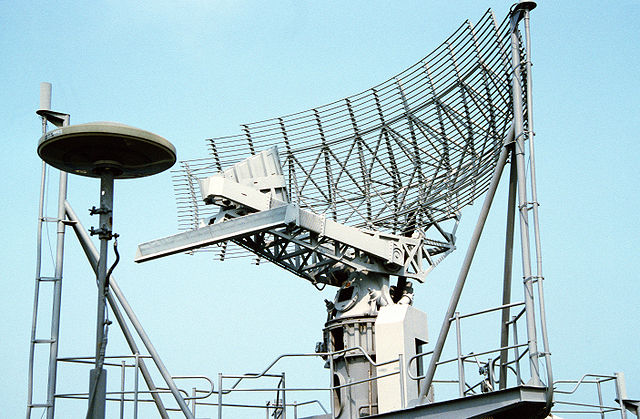
360 kW peak radar installed in 1975, Frq L band 851–942 MHz, range 3 nmi (5.6 km) to 256 nmi (474 km) on the AN/SPS-49A(V)1, 150,000 ft (45,720 m) at 1/16 nmi range prec.
AN/SPS-55 Surface search radar

1971 solid state surface search and navigation radar from Cardion Electronics. I band radar (two waveguide slotted arrays back-to-back) for linear polarisation/circular polarisation, more effective in reducing returns from precipitation. 130-160 kW peak power, Frq 9.05 to 10.0 GHz, range 50 nautical miles (92.6 km).
2x AN/SPG-51 Missile fire control radar
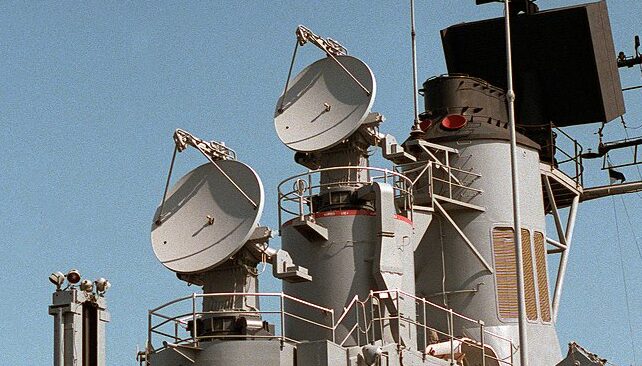
A classic with cone dish-like array mounted on superfiring position to manage each a single missile to target. The AN/SPG-51 is both used for tracking and illumination fire-control, originally developed for the RIM-24 Tartar and later used on the similar RIM-66 Standard and integrated in the Mk. 73 gun and missile director system. Monopulse radar, Pulse-Doppler signal processed in MK 74 MOD 14 and MK 74 MOD 15, the latter with continuous-wave radar tracking for illumination and missile guidance. 4000 kw in illumination, 1800 in tracking.
2x Mk 86 Gun Fire Control System
The MK 86 GFCS are a central sub-element in the Gun Weapons System (GWS). Dual remote control for the California’s both forward and aft 5″/54 caliber guns to engage their own targets.
Various GFCS modes to calculate ballistic orders modified by console operators with environmental data. Directed against surface radar/optically tracked targets or indirect firing in fire support. More.
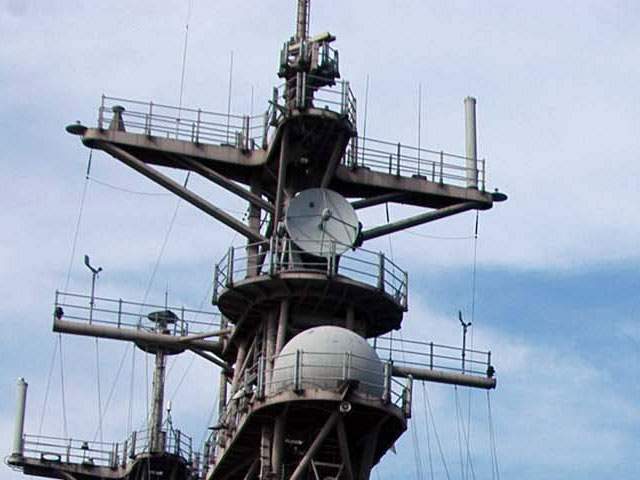
Mast on USS Cushing DD-985 showing both the radome of the Mk 86 GFCS and AN/SPQ-9 dish array on the above platform (crowned by an SPS-55).
AN/SPQ-9 Search and fire control radar
The AN/SPQ-9A (“spook nine”) was a multi-purpose surface search and fire control radar lined to the Mk-86 GFCS, 2D to provide range and bearing, not elevation. Detects and track targets at sea level, surface and low altitude (below 2000 ft) air targets, and usable for standard navigation. Deployed among others on the Spruance/Kidd-class and Arleigh Burke-class destroyers, Ticonderoga, California and Virginian class cruisers as well a Tarawa-class amphibious assault ships.
2x AN/SPG-60 Gun fire control radar
The “SPIG sixty” is alsop part of the MK-86 GFCS for air tracking and backup illumination for the RIM-66 Standard. Primary its an air tracking radar, usable on the margin for surface tracking and with a boresight mounted camera, for optical tracking, engagement and damage assessment.
AN/SQS-26 Bow mounted sonar
27,215 kg (59,999 lb) operating as passive sonar (FRQ 1.5 kHz) or active at 3–4 kHz. Max output 240 kW, range 18-64 km (11-40 mi), direct path, bottom reflected, passive and convergence zone (CZ) capabilities. Manufacturer: General Electric Heavy Military Electronic. Replaced by the CX variant capable of 360° long-range sector search at low frequency and later by the AN/SQS-53 A/B/C with digital computer interface.


⚙ specifications |
|
| Displacement | 10,600 long tons (10,800 t) |
| Dimensions | 587 x 61 x 31ft 6in (179 x 19 x 9.60 m) |
| Propulsion | 2× General Electric D2G reactors: 60,000 shp (45,000 kW) |
| Speed | 30 knots+ (56 km/h), classified |
| Range | Unlimited |
| Armament | 2× Mk 141 Harpoon, 2× 5-in/54 Mk 45, 2× CIWS, ASROC, 2× RIM-66D, 2×3 12.75″ Mark 46 TT, 4 HMG |
| Sensors | AN/SPS-48E, AN/SPS-49, AN/SPS-55, AN/SPG-51, Mk 86 GFCR, AN/SPQ-9, AN/SPG-60 GFCR, AN/SQS-26 sonar |
| Protection | Passive 1986-87: Kevlar additions, see notes |
| Air Group | Helicopter deck: SH-2 Seasprite LAMPS Mk1, SH-3 Sea King, CH-46 Sea Knight. |
| Crew | 40 officers and 544 enlisted |
Modernization and assessment
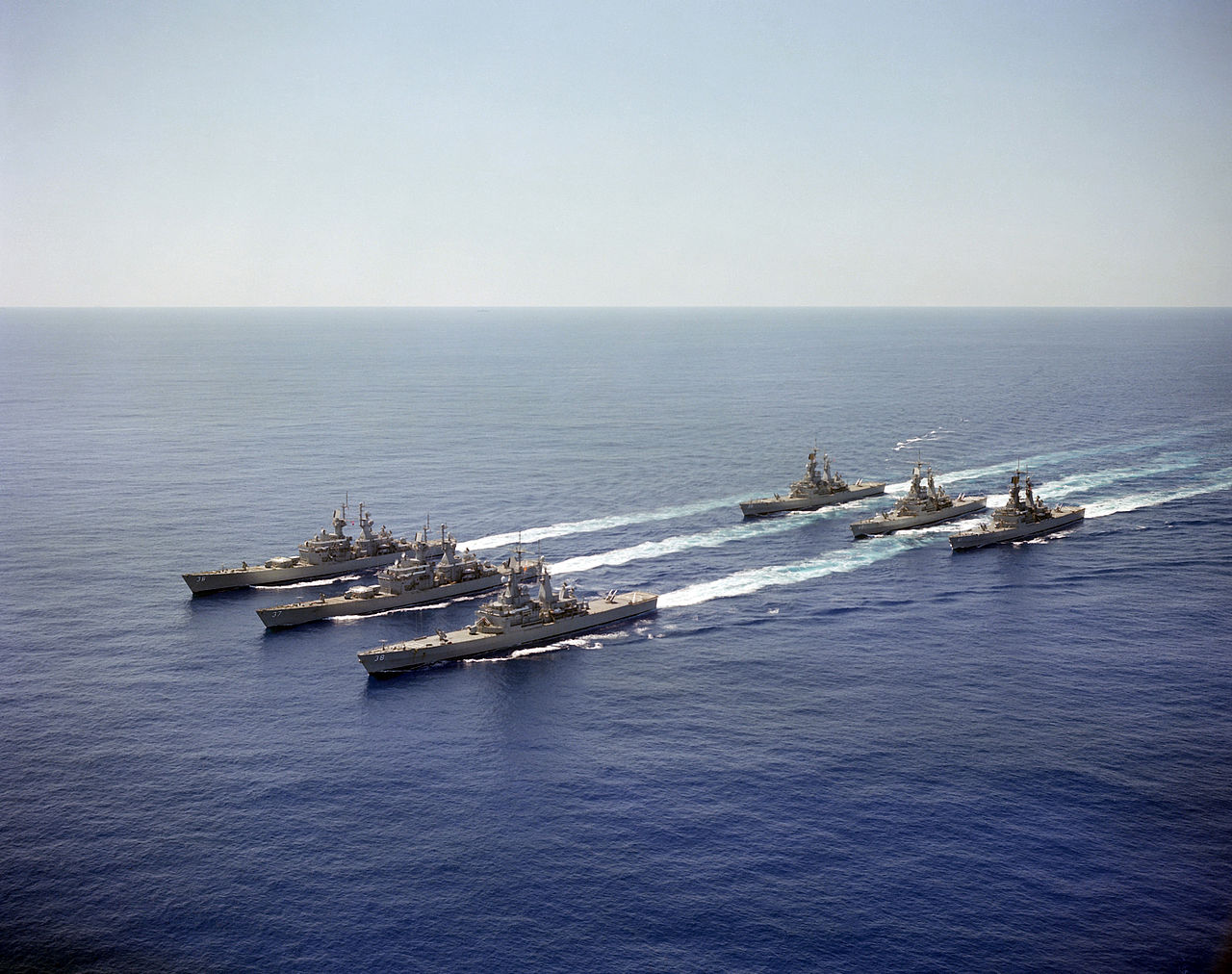
Six nuclear cruisers in formation, 1980s, the two California and four Virginia.
In the late 1970s, the first major addition for both was a set of two quadruple Harpoon SSM (8 RGM-84A) canisters installed forward of the aft island rear amidship.
In the early 1980s, their WLR-1 and WLR-3 ECM suites were removed as well as their Mk 28 decoy launchers. Instead were installed two 6-tube 20mm/76 Mk 15 Phalanx CIWS for close defense and well as four single 0.5-in/90 Browing M2HB HMG to deal with asymetric threats. On the elevtronic level, they adopted the new Mk 90 fire control radars, as well as the SLQ-32(v)3 ECM suite and four Mk 36 SRBOC decoy RL for better coverage at all angles, as well for the first time, the T-Mk 6 Fanfare torpedo decoy at the stern.
In 1986-1987, both received a set of Kevlar armour panels setup over “vitals” (see notes above).
1993-94 saw for both the removal of their ASROC ASuR systems, as well as the SPS-40B and SPS-48C as well as SPS-10 and LN-66 radars in exchange of the SPS-49(v)5, SPS-48E, SPS-64(v)9, SPS-67(v)1 radars. Aramment was reinforced by two more Browing M2HB HMGs, for 4 total, and to deal with incoming wake/homing torpedoes, they carried the latest SLQ-25 Nixie torpedo decoy.
The California class when in service in the 1970s became the most powerful and modern surface warfare assets in USN history. They had the new SM-1 series SAM (single arm) Mk13 Mod 3 launchers fore and aft, two 5 inch guns also fore and aft as true double enders. Later they received an anti-ship capability with Harpoon SSMs. Close defence was reinforced by 20mm CIWS, while they kept their complete USW capability between ASROC and their Mk46 TTs but no TLAMs or ASW helicopter with hangar.
The Sensor suite was a powerful mix of 3D and 2D long and medium/low alt. range air search radar, surface search radars and fire control radars, but they also had the best EW protection in the navy, with new and efficient passive electronic surveillance and jamming systems. Thus created a safe bubble 70 nautical miles across to protect themselves, the CGB, while they could reach any point in the globe at 30 knots plus and stay there as long as there was RAS for the crews, or even crew changes as practiced by the USN in the 1980-90s. But still, they were large, costly to built and operate and thus, axed when the next class was envisioned, again to be ‘mass produced’ in the early 1971 but yet again, CGN-42, the fifth of the Virginias was axed and never laid down. The “mass” supposed to provide AEGIS capabilities to US CBG and Amphibious TFs around the world, would be incarnated with cheaper and smaller conventional hulls.
 USS California CG-36
USS California CG-36
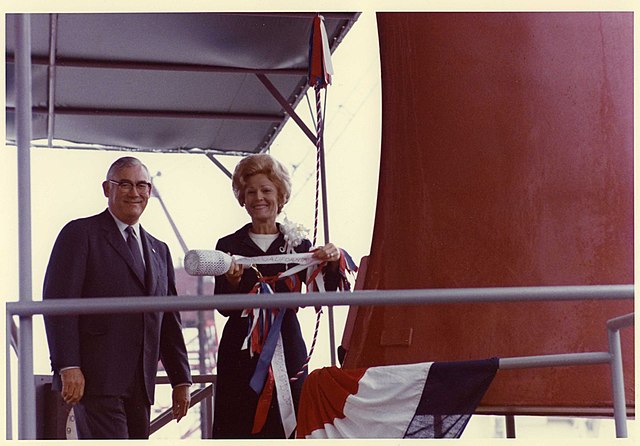
“Pat” Nixon launches the traditional bottle on USS California’s prow at Newport News SB, 22 Sept. 1971.
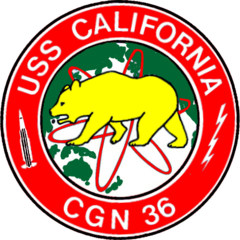 USS California was commissioned on 16 February 1974 in a ceremony by James E. Johnson, Assistant Secretary of the Navy and commissioned at the time as destroyer leader (DLGN). With 10,000 tonnes, she was the largest “destroyer” ever to enter US service and something probably baffling by still numerous WW2 vets. Her designation however would be altered on 30 June 1975 as guided-missile cruiser (CGN), better reflecting her size and capabilities. Her initial service in 1975-77 included the usual base training, weapons and sensors qualifications and shakedown cruise with post-fixes.
USS California was commissioned on 16 February 1974 in a ceremony by James E. Johnson, Assistant Secretary of the Navy and commissioned at the time as destroyer leader (DLGN). With 10,000 tonnes, she was the largest “destroyer” ever to enter US service and something probably baffling by still numerous WW2 vets. Her designation however would be altered on 30 June 1975 as guided-missile cruiser (CGN), better reflecting her size and capabilities. Her initial service in 1975-77 included the usual base training, weapons and sensors qualifications and shakedown cruise with post-fixes.
Early on, she suffered damage while in Norfolk harbor due to a brief and intense squall, after breaking her moorings and drifting, then colliding stern vs. prow with USS Thomas C. Hart (FF-1092) at the same pier on 6 June 1977.
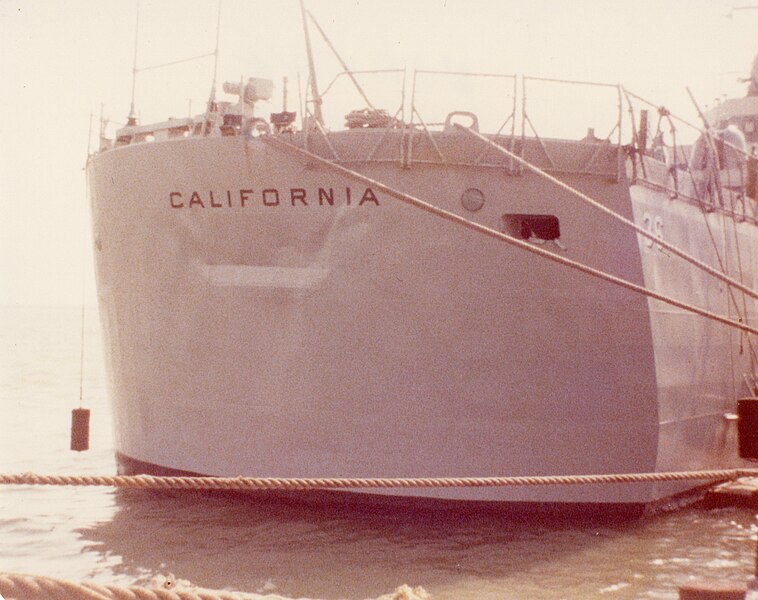
USS California’ stern damage 1977.
Soon after she sailed to UK, representing the U.S. Navy at the Queen’s Silver Jubilee and naval review in Portsmouth. By January 1980, she made aher first long deployment with the 6th fleet in the Mediterranean to the Indian Ocean, joining operations in the red sea after hostage crisis in Iran. She avoided Suez and instead left the Mediterranean at flank speed, veered south through the Atlantic, cornered Africa into the Indian Ocean. In April 1980, she worked with the Air Force, Marines, and Army for the failed Operation Eagle Claw.
In 1981, she circumnavigated the globe, the first time it happened since Operation Sea Orbit and USS Enterprise CBG in 1964.
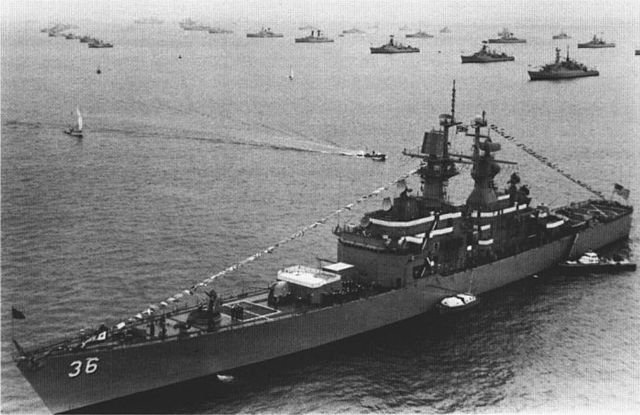
1977 Spithead Fleet Review
In September 1983 she received news of her homeporting from Norfolk to NAS Alameda on the west coast, California. Soon after she sailed for her first WestPax/Indian Ocean cruise by February 1985, with her first major long CBG escort, in USS Constellation battle group. Tha spring of 1986 saw her in the Bering sea, first nuclear cruiser to visit Adak in Alaska. She completed her WestPac and after maintenance, completed a second World cruise in 1987.
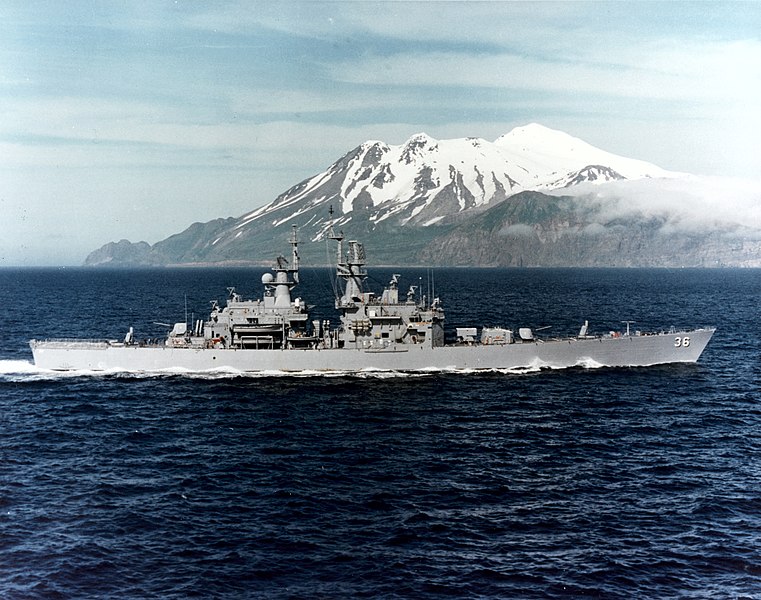
Underway Pacific 1980s
In 1988 brought she returned for a 3rd Western Pacific/Indian Ocean, this time as CBG ASW Commander in RIMPAC 88 exercises, and she was present off Seoul during the Olympic games in Korea. In her 1988–1989 deployment she became AAW Commander, when deployed in the North Arabian Sea, Persian Gulf as the Iran-Iraq war was concluding. She patrolled the Strait of Hormuz by December 1988 for Operation Earnest Will, leading the very last convoy mission there.
Summer 1989 saw her in Northern Pacific exercises, to test CBG Near-Land Operating Areas. September-October 1989 saw her as AAW picket ship for PACEX 89, largest combined allied fleet since WW2.
By April 1990, she was in Puget Sound Naval Shipyard for her major, three-year refueling complex overhaul. She was notably fitted with the brand new D2G high endurance reactor cores and had added internal fuel and general capacity for 20 years operations. She also received the now standard TUCSS, ancestor of NTDS (Threat Upgrade Combat Systems Suite), kevlar armour, a complete new set of radars, new ECM suites and other changes for $425 million to US taxpayers when completed in January 1993. After the usual post-refit shakedown and fixes, then weapons/sensors crew qualifications and refresher cruise, coordinated battle group exercises and cross evaluations, until she was ready for her next deployment. California and South Carolina were intended to serve as long as possible, in replacement for older generation of CGNs, including the USS Bainbridge/Truxtun.
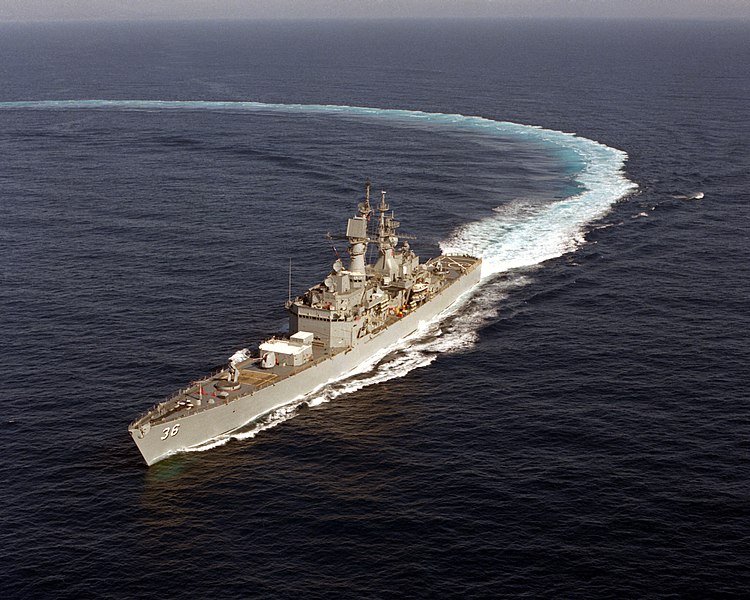
Underway off southern California Nov. 1986
However this changed as the Virginia-class cruisers were about to gave their own refueling, the cost spiralled out of control. So with a noew post-cold war context, the Navy had the four Virginia-class cruisers decommissioned and concentrate of the two Californias instead; By June 1994, USS California joined USS Kitty Hawk CBG in the Western Pacific, carrying Korean Navy personal in a combined exercise, also including JSDMF at ANNUALEX 06G and Keen Edge 95 later and LINKEX off Korea, to built an indispensable tactical data link between regional navies. She concluded by Tandem Thrust 95 with the RAN and other Pacific fleets. She was back for maintenance at Christmas 1994 over 4 months.
In September 1995 she took part in a parade for the commemoration of Pearl Harbor and by May 1996, made another WestPac conducting her in the Persian Gulf for six-month with USS Carl Vinson CBG, earning a Meritorious Unit Commendation for operation Southern Watch and Desert Strike and AAW Commander.
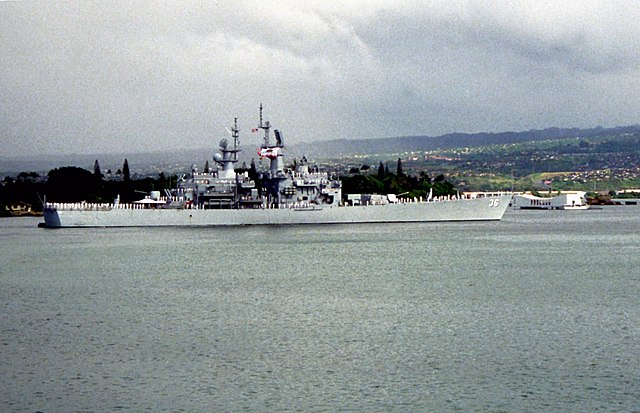
Pearl Harbor 1990
After maintenance of spring 1997, she trained and practice live missile fire, haiving an Operational Reactor Safeguards Examination to assess her readiness, including a final Evaluation Period, earning another “E” award in 1997. By January 1998, she was in Eastern Pacific and Caribbean/Mexico gulf for Counterdrug Operations, as AAW Commander for JIATF East. In July she took part in RIMPAC 98. By 1998, the Navy reported on their eye watering $38.8 million maintenance cost with 600 complement, compared to a Ticonderoga-class $29.5 million annually (with AEGIS), with 400 crew. They also, unlike the latter, lacked helicopter hangar, were seemed as weak in ASW area, and the cost of nuclear-trained personal entered also in consideration. All this weighted in the balance, despite the great upgrade cost destined to add 20 years to their service from 1993, so bringing them to 2013.
Instead it was decided to have the deactivated, which for California was done on 28 August 1998 at Puget Sound, Bremerton, effective on 1 October, then stricken on 9 July 1999. Disposed of, she joined the Nuclear-Powered Ship-Submarine recycling program at Puget Sound for a long process only completed on 12 May 2000.
 USS South Carolina CG-37
USS South Carolina CG-37
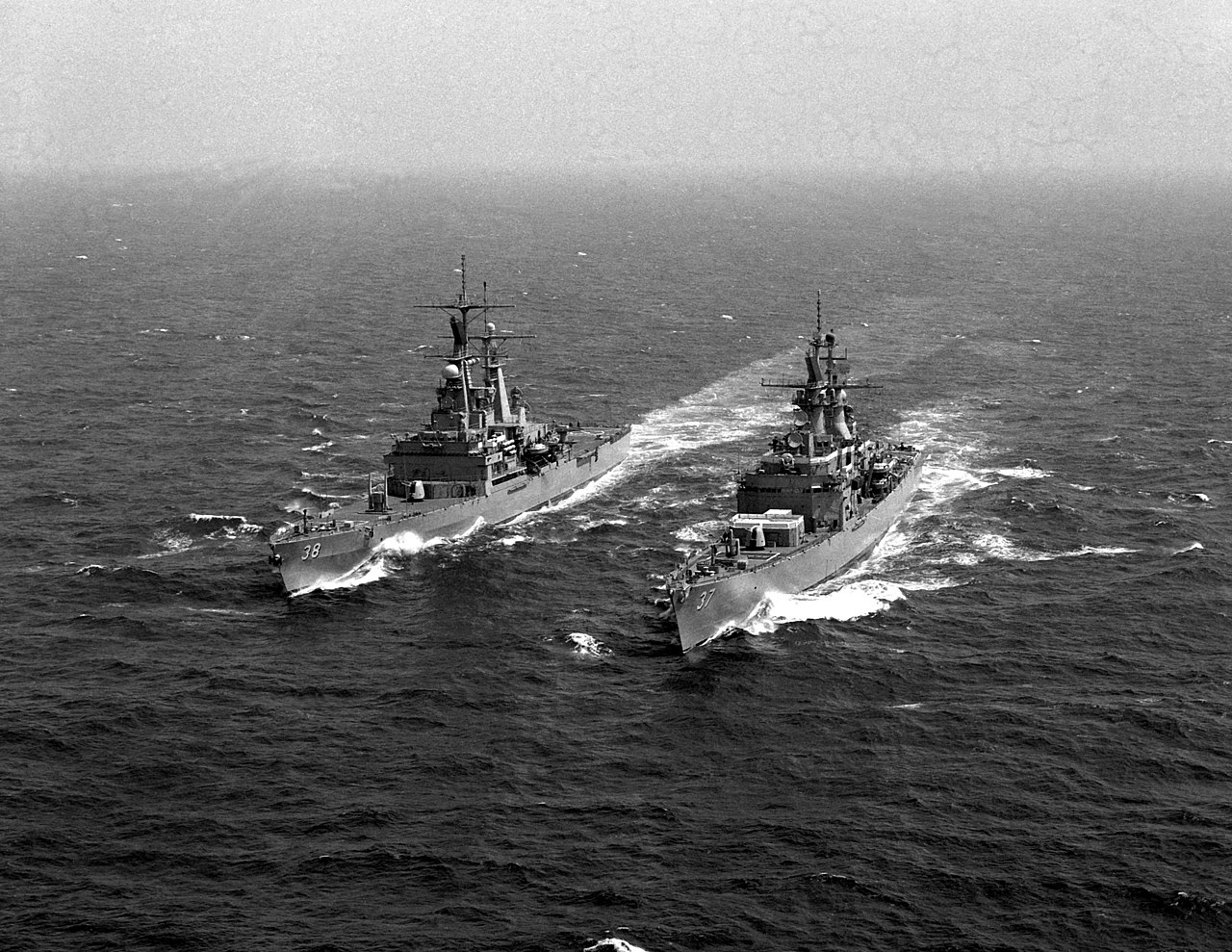
 An elevated bow view of the nuclear-powered guided missile cruiser USS VIRGINIA (CGN 38) and USS SOUTH CAROLINA (CGN 37) underway.
An elevated bow view of the nuclear-powered guided missile cruiser USS VIRGINIA (CGN 38) and USS SOUTH CAROLINA (CGN 37) underway.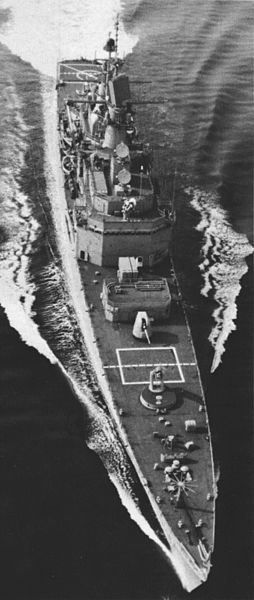 USS South Carolina was commissioned as DLGN-37 on 25 January 1975, redesignated CGN-37 just six months later. She went through the usual training and qualifications, shakedown cruise and post-fixes in 1975-76, before a first North Atlantic deployment in the USS Nimitz Battle Group in later 1976. She took part in Exercise Solid Shield in the Caribbean and started her first Mediterranean deployment in February 1977, with USS California with Nimitz for her second Mediterranean deployment by November 1977 and back to Norfolk by July 1978. She made her third MedT by January 1979 with Dwight D. Eisenhower CBG.
USS South Carolina was commissioned as DLGN-37 on 25 January 1975, redesignated CGN-37 just six months later. She went through the usual training and qualifications, shakedown cruise and post-fixes in 1975-76, before a first North Atlantic deployment in the USS Nimitz Battle Group in later 1976. She took part in Exercise Solid Shield in the Caribbean and started her first Mediterranean deployment in February 1977, with USS California with Nimitz for her second Mediterranean deployment by November 1977 and back to Norfolk by July 1978. She made her third MedT by January 1979 with Dwight D. Eisenhower CBG.
In 1980, she followed the first Atlantic battle group in its first deployment in the Indian Ocean. She made another depliyment with “Ike” by January 1982, six-month and by 1985, she trained in the Caribbean. She was back in the Mediterranean in March, over seven months and 46,500 miles, staying mostly off Lebanon after tension following the hijacking of TWA Flight 847. She had maintenance October 1985 – June 1986 and by July 1986 made a North Atlantic cruise to Wilhelmshaven, Oslo, and back to Norfolk, and by 30 December 1986 departed with the Nimitz CBG retaking her post off Lebanon. By June 1987, soon after the frigate USS Stark had been hit by Iraqi missiles, she made a standoff in the Gulf of Sidra. At one point a threatening incoming jet was jammed at full powered and had to fold back, with diplomatic protest. Joint exercises saw her past the Arctic Circle later to Wilhelmshaven, hosting notably British naval historian Eric Grove, and back home by October 1988.
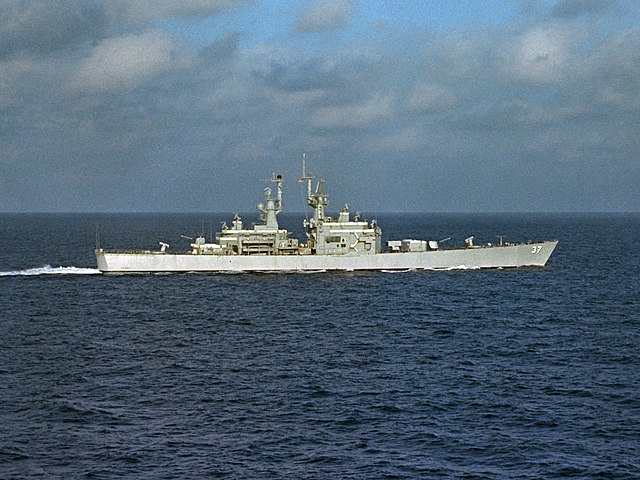
She made another Mediterranean tour by December 1988 (her sister was now in the pacific) and trained with CBG Theodore Roosevelt, hosting helicopters from ASW Squadron 9 to rescue 15 British yachts crews disabled during a race in heavy weather, live TV broadcasted. She was back to Norfolk on 30 June 1989, for 4 months maintenance, and a short hop in the Caribbean to assist USS Forrestal CBG.
On 5 January 1990 she was off Guantanamo Bay and returned on the Mexican waters on 12 March 1990 for her tour of war on drugs on 13 April 1990 with the Coast Guard. She even became COMCARIBRON flagship and returned later for more intensive counter narcotics operations as flagship Joint TG4 plus COMCARIBRON. By 1 October 1990 she joined CBG Saratoga in the red sea, and for this, crossed the Atlantic to the Mediterranean, Suez Canal and too part in Operation Desert Shield as flagship for COMDESRON 24. In all she made 27 boardings with the Interdiction Force, congratulated by CNO Admiral Frank Kelso on 7 November 1990. She would have like her sister her fair share of awards (see later).
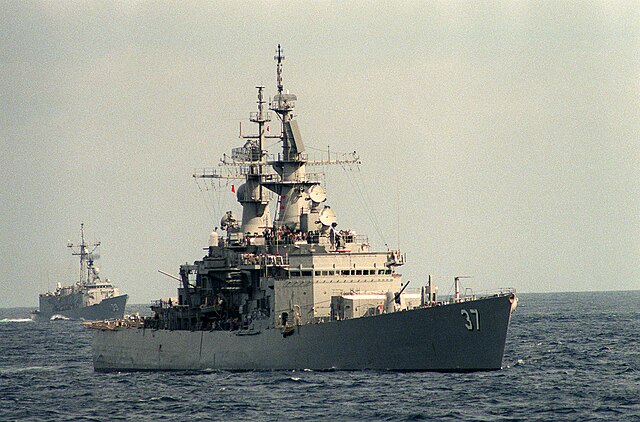
She later visited Jeddah in Saudi Arabia, a first for nuclear ship, and by January 1991 returned to Roosevelt CBG in the Central Mediterranean, making a aintenance and R&R at Taranto on 17 January 1991 before Operation Desert Storm commenced. She acted as AAW Commander for Operation Silver Cloud (creating air corridors and Suez Canal area defense). She supervised a rescue for the sinking merchant Continental Lotus. She was back home by 28 March 1991, and had major upgrades at Norfolk (CS NTU, reactors core, other upgrades as her sister until over on 30 March 1994.
After her refresher cruise she took part in Operation Able Vigil, the rescue and safe passage of thousands of Cuban migrants to Florida, earning the Coast Guard Unit Commendation. This ended by November 1994 and she was prepared for her next major (11th) deployment, by the fall of 1995.
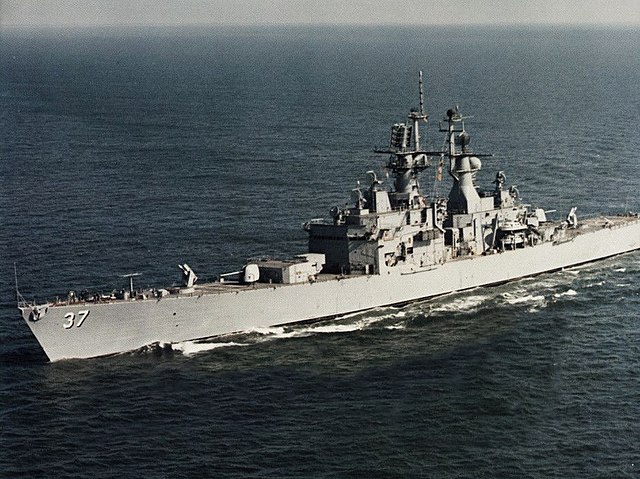
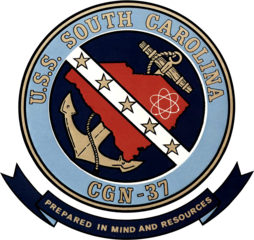 This time she headed for the turmoiled Yugoslavia for Operations Deny Flight, Sharp Guard, Decisive Endeavor, as part of Joint Endeavor. She became “Red Crown”, AAW Commander, Adriatic, earning mroe awards. She was back home in the spring 1996. She joined in the spring of 1997 CBG USS George Washington and until June 1997 took part in COMPTUEX as AAW Commander. It was the largest SAM exercise in the Atlantic fleet ever.
This time she headed for the turmoiled Yugoslavia for Operations Deny Flight, Sharp Guard, Decisive Endeavor, as part of Joint Endeavor. She became “Red Crown”, AAW Commander, Adriatic, earning mroe awards. She was back home in the spring 1996. She joined in the spring of 1997 CBG USS George Washington and until June 1997 took part in COMPTUEX as AAW Commander. It was the largest SAM exercise in the Atlantic fleet ever.
By August, she took part in Fleetex and completed preparations for her deployment on October 1997, in the Mediterranean, stopping at Haifa, Naples, Rota, underway and acting as 6th Fleet AAW Commander, also taking part in three major NATO exercises, back home on April 1998. Soon after she sailed for six weeks of Counter Narcotics operations, SW Caribbean, stopped at Charleston in August and returned to Norfolk to learn the Navy dedided to have her deactivated, which took place on 4 September 1998.
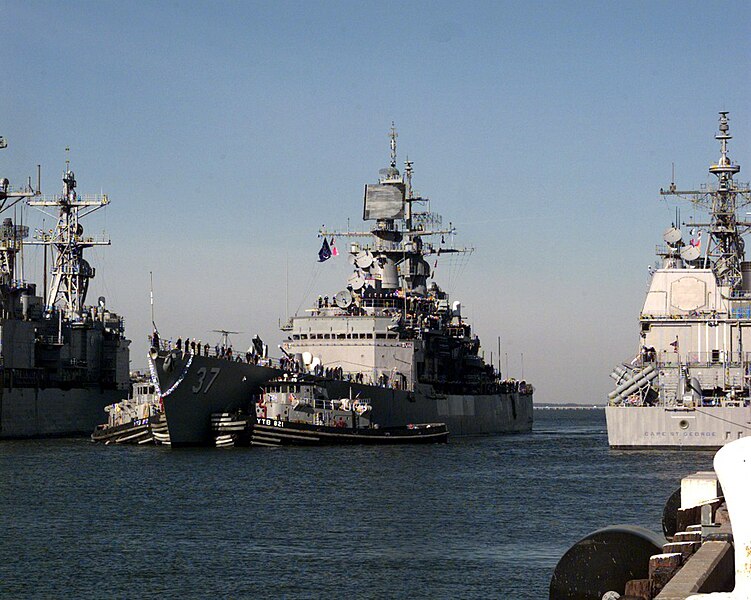
By July 1999 she was towed through the Panama Canal, to Bremerton’s Nuclear Powered Ship and Submarine Recycling, Puget Sound facility, on 1 October. She was stricken on 30 July 1999, scrapping competed on 10 May 2010. Her bow however was preserved to the Puget Sound Memorial Plaza. Her nuclear reactor compartments were sent by barge to the Hanford Nuclear Reservation in long term storage.
Read More/Src
Books
Conway’s all the world’s fighting ships 1947-95
Links
nationalinterest.org naval masterpiece
navsource.org california
navsource.org south carolina
seaforces.org/ California-class.htm
navalanalyses.com/ california
man.fas.org/ cgn-36.htm
man.fas.org cgn-36cl.htm
webarchive.loc.gov/ history.navy.mil/
nvr.navy.mil SHIPSDETAIL CGN 37
navypedia.org/ us cr california
en.wikipedia.org/ California class cruiser
awards.navy.mil/
Videos
Model Kits
General query
USS California CGN-36 1985 Iron Shipwrights 1:350
USS California CGN-36 Naval Works 1:700
CGN-36 California Wave Line Series Resin Cast Kit Pit-Road 1:700
USS California CGN-36 Argos by Jeorg Uter 1:1250
On sdmodelmakers.com

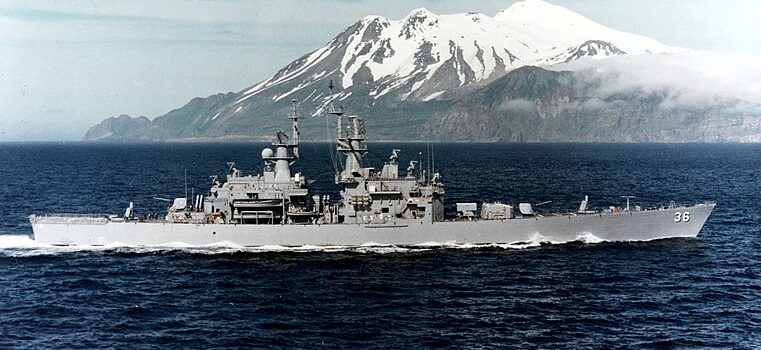
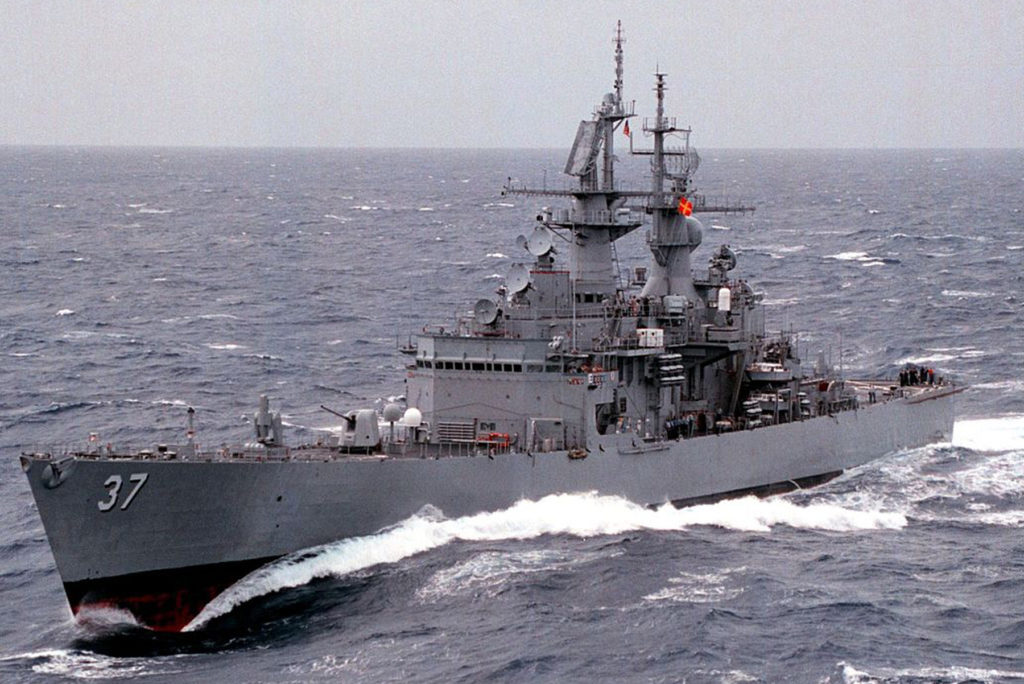
 Latest Facebook Entry -
Latest Facebook Entry -  X(Tweeter) Naval Encyclopedia's deck archive
X(Tweeter) Naval Encyclopedia's deck archive Instagram (@navalencyc)
Instagram (@navalencyc)





 French Navy
French Navy Royal Navy
Royal Navy Russian Navy
Russian Navy Armada Espanola
Armada Espanola Austrian Navy
Austrian Navy K.u.K. Kriegsmarine
K.u.K. Kriegsmarine Dansk Marine
Dansk Marine Nautiko Hellenon
Nautiko Hellenon Koninklije Marine 1870
Koninklije Marine 1870 Marinha do Brasil
Marinha do Brasil Osmanlı Donanması
Osmanlı Donanması Marina Do Peru
Marina Do Peru Marinha do Portugal
Marinha do Portugal Regia Marina 1870
Regia Marina 1870 Nihhon Kaigun 1870
Nihhon Kaigun 1870 Preußische Marine 1870
Preußische Marine 1870 Russkiy Flot 1870
Russkiy Flot 1870 Svenska marinen
Svenska marinen Søværnet
Søværnet Union Navy
Union Navy Confederate Navy
Confederate Navy Armada de Argentina
Armada de Argentina Imperial Chinese Navy
Imperial Chinese Navy Marinha do Portugal
Marinha do Portugal Mexico
Mexico Kaiserliche Marine
Kaiserliche Marine 1898 US Navy
1898 US Navy Sovietskiy Flot
Sovietskiy Flot Royal Canadian Navy
Royal Canadian Navy Royal Australian Navy
Royal Australian Navy RNZN Fleet
RNZN Fleet Chinese Navy 1937
Chinese Navy 1937 Kriegsmarine
Kriegsmarine Chilean Navy
Chilean Navy Danish Navy
Danish Navy Finnish Navy
Finnish Navy Hellenic Navy
Hellenic Navy Polish Navy
Polish Navy Romanian Navy
Romanian Navy Turkish Navy
Turkish Navy Royal Yugoslav Navy
Royal Yugoslav Navy Royal Thai Navy
Royal Thai Navy Minor Navies
Minor Navies Albania
Albania Austria
Austria Belgium
Belgium Columbia
Columbia Costa Rica
Costa Rica Cuba
Cuba Czechoslovakia
Czechoslovakia Dominican Republic
Dominican Republic Haiti
Haiti Hungary
Hungary Honduras
Honduras Estonia
Estonia Iceland
Iceland Eire
Eire Equador
Equador Iran
Iran Iraq
Iraq Latvia
Latvia Liberia
Liberia Lithuania
Lithuania Mandchukuo
Mandchukuo Morocco
Morocco Nicaragua
Nicaragua Persia
Persia San Salvador
San Salvador Sarawak
Sarawak Uruguay
Uruguay Venezuela
Venezuela Zanzibar
Zanzibar Warsaw Pact Navies
Warsaw Pact Navies Bulgaria
Bulgaria Hungary
Hungary

 Bundesmarine
Bundesmarine Dutch Navy
Dutch Navy Hellenic Navy
Hellenic Navy Marina Militare
Marina Militare Yugoslav Navy
Yugoslav Navy Chinese Navy
Chinese Navy Indian Navy
Indian Navy Indonesian Navy
Indonesian Navy JMSDF
JMSDF North Korean Navy
North Korean Navy Pakistani Navy
Pakistani Navy Philippines Navy
Philippines Navy ROKN
ROKN Rep. of Singapore Navy
Rep. of Singapore Navy Taiwanese Navy
Taiwanese Navy IDF Navy
IDF Navy Saudi Navy
Saudi Navy Royal New Zealand Navy
Royal New Zealand Navy Egyptian Navy
Egyptian Navy South African Navy
South African Navy






























 Ukrainian Navy
Ukrainian Navy dbodesign
dbodesign